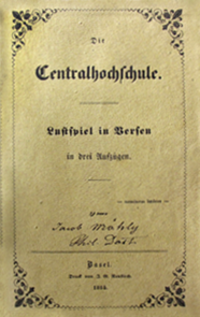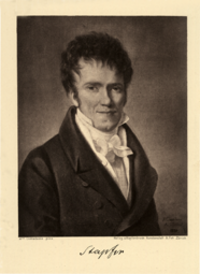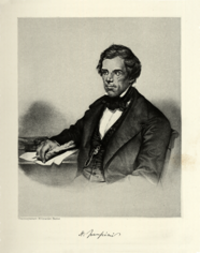On the advantages and disadvantages of a federal university: a contentious debate amid competing interests of the Swiss federal government and Basel
A Swiss federal university has never established, but the idea has left its mark, sparking a debate that stirred federal imaginations for more than a hundred years. When it seemed, in the mid-nineteenth century, that words might be followed by action, Basel mounted a vigorous campaign of opposition. Given the precarious financial situation, the city feared losing its university to a federal institution.
The proposal for a central Swiss educational institution first reached a wider political audience around the middle of the eighteenth century. In his treatise “Patriotische Träume eines Eydgnossen” (Patriotic dreams of a Swiss citizen), the Lucerne councillor Franz Urs Balthasar called for a federal “nursery” for prospective statesmen of both confessions, where he envisioned students would learn what they needed to benefit their fatherland, while paying special attention to the rules of virtue and friendship.
Invoking such high moral ideals served an immediately practical purpose: Urs hoped that educating future decision-makers together would bring greater unity to the Confederation. His vision was that such a nursery might remedy the Confederation’s much-criticized fragmentation. Urs’s pamphlet, published by Isaak Iselin, the secretary of the Basel City Council, met with an enthusiastic response in reform circles and initiated the Helvetic Society founded around Iselin. As far as the foundation of a federal educational institution was concerned, however, for the time being this remained nothing but a dream.
Centralized politics with centralized ideas: from the Helvetic Republic to a federal state
Under the Helvetic Republic (1798–1803), the idea of central Swiss government reemerged as a topic of public discussion. Philipp Albert Stapfer, at the time the “Helvetic minister of sciences, arts, buildings, bridges, and roads,” repeatedly advocated for the establishment of a federal university. But the resistance he encountered proved insurmountable over the short years of the republic, preventing any substantial advancement of his plans, and the issue gained real significance only with the founding of the federal Swiss state in 1848. The debate – previously conducted in more theoretical terms – was now given a constitutional footing: Article 22 of the first Swiss Federal Constitution granted the state the authority to establish a federal university alongside a polytechnic institute. What had been merely a dream for more than a century now seemed to be approaching realization.
And at least as far as the polytechnic institute was concerned, this appearance was not deceptive. Among the Swiss university cities, a university limited to technical fields provoked less fear of competition. Unlike a federal university, such an institution was not intended to be a new venue for the traditional curriculum but aimed to pave the way for the country’s technical-industrial modernization. The aim was to produce the knowledge needed to build a national infrastructure tailored to Swiss needs. That said, the engineering school was intended not just to facilitate the tangible material realization of a federal state bound together abstractly by the constitution, but also to create new career opportunities for a federal elite.
It was easy to reconcile these national concerns with local scientific ambitions. The fact that they could be realized within a short period of time in the foundation of the Zurich Polytechnic was largely due to the efforts of Federal Councillor Stefano Franscini, who had been advocating since 1848 as head of the Department of the Interior for the establishment of both a federal university and a technical university. The bill to establish a “federal polytechnic school in conjunction with a university for advanced studies in the exact, political, and humanistic sciences” in Zurich was approved by the National Council on February on 7 February 1854. By 16 October of the following year, lessons had already begun at various locations throughout the city.
Federalist fear of the “central dagger “
Events took a different turn for the second institution mentioned in Article 22 of the Federal Constitution of 1848: now enshrined in law, the possibility of a “central university” proved to be far less popular than expected. And above all, over the next few years years it caused more discussion than the idea of polytechnic institute, which was only approved after it became evident that the efforts to establish a federal university could not earn majority support because of fears that it would pose a threat to existing universities, with their traditional range of subjects.
In Basel especially, the constitutional possibility of a central university provoked unease, as there was little likelihood that the new institution would be located in the city. Many supporters of the project saw the federal university – and later the polytechnic institute – as a means of compensating Zurich for the choice of Bern as the federal capital. Continuing to fund Basel’s local university alongside a central institution in Zurich would have meant a difficult financial burden, however, and this was a concern in Basel that was also shared in Bern. In a speech delivered as rector of the university in Bern, theology professor Albert Immer predicted that the city’s own university would be nothing more than a “pitifully vegetating institution” should a “general federal university rise up over the ruins of our small cantonal university institutions.” Each university canton, namely, would have had to divert a significant portion of funding for their local universities to support the new federal institution. Balthasar’s vision of a nursery that would animate the country’s political life thus became, in academic pub talk, a “central dagger” imperiling the existence of the cantonal universities.
A proposal to abolish the university and its consequences
Two years after the first Federal Constitution came into force, the situation in Basel came to a head: in December 1850, the Basel citizen Daniel Senn submitted a motion to the Grand Council to abolish the university, citing the financial burden it posed. At the time, it was the smallest in the country, with only about sixty students in 1850, while the other three Swiss universities in Bern, Geneva, and Zurich had consistently recorded over 100 enrollments for some time. Of the 554 students enrolled in the four institutions in 1849/50, Basel accounted for not even a quarter — only 10.5 percent. Cost was thus the primary reason cited for the proposal to abolish the institution: the financial expense, it was claimed, simply could not be justified by the small number of students.
Should there be political will to secure an institution of higher education for Basel, so the argument continued, two alternatives presented themselves: either to close the city’s university and fight for the establishment of a federal university on the basis of old structures; or to promote the performance and benefits of the cantonal universities in order to help assure their preservation. Within a few weeks and even before the motion was discussed in the council, the media had explored both paths. A pamphlet called “New Year’s Wish,” published anonymously in Basel at the beginning of 1851 and addressed to the “fellow citizens of Basel City,” pleaded for the city to be established as the pinnacle of scholarship, as the “central peak of the sciences,” while Professors Schnell and Schönbein, as members of the august institution, advocated for its continued existence.
Both proponents and opponents of a federal university framed their arguments within the discourse of patriotic common good, cloaking their individual interests behind a mantle of national perspectives. Depending on their position, they sought to demonstrate how either a federalist or a centralist science policy would best serve the welfare of the entire country and its individual parts. In the Grand Council in February 1851, an anticentralist sentiment prevailed, and Senn’s motion was decisively rejected with eighty-one to eleven votes.
“… that continued centralization will directly open us up to monarchy ...”
The question of a central university did not remain dormant in Basel for long. By July 1851, a commission appointed by the Federal Council to deliberate establishing a federal university and a polytechnic school published a report of its findings with two draft laws, coming to the “preliminary conclusion that significant and undeniable needs demand that such an institution be established.”
Again, the reactions were quick in coming. Almost simultaneously with the report of the Federal Council’s commission, the Basel professor of Greek Wilhelm Vischer-Bilfinger published a pamphlet in Bern that can be read as a direct response to the centralist efforts, drawing a contrast between “Swiss distinctiveness” based on the achievements of federalism, and Prussian officialdom and French monarchy. At the time, the monarchical structures of France served as a threatening foil not only for Vischer’s argument, but wherever a battle was being waged against centralist tendencies. Attempts to distinguish Switzerland from Germany, however, were usually made less through polemic attacks on centralization and more through criticism of bureaucracy and its mindset. Unlike in France, of course, in German political life centralization failed to take hold in any significant way, even under the Holy Roman Empire.
As an opponent of all forms of bureaucracy, Vischer saw the planned central university as nothing other than a “nursery for officials, a stable to train servants for the federal government”; and in the Federal Council’s commission report, he saw not a trace of any attempt to consider “Swiss distinctiveness.” “The entire proposal,” he continued, “would [instead] precisely replicate, as far as we have been able to see, the foremost and best German university.”
In January 1854, after a bill was presented to the Swiss Council of States to establish an institution that would combine the proposed university and polytechnic school, Rudolf Merian emerged as another citizen of Basel who was critical of centralization. Spearheading the opposition in the Council of States, he argued that a Swiss federal university would serve only German-Protestant eastern Switzerland, while producing serious disadvantages for the other parts of the country. The Council of States followed his lead and rejected the bill by twenty-seven votes to fifteen.
Opposition grew up, moreover, not only in politics but in literature, too. In 1854, for instance, a comedy in verse form (see the figure) was published, in which Jakob Achilles Mähly, a young classical philologist from Basel, mocked the idea of a federal university and its supporters. The three-act piece portrays the downfall of a fictitious central university as a farce of what would most certainly follow should such a school in fact be established.
From forte to piano: a slow fade-out over one hundred years
The same debate resurfaced in Swiss politics just under a decade later, between 1862 and 1864. In his treatise “The Swiss Federal University,” Eugen Rambert, professor of Romance studies at the academy in Lausanne and at the Federal Polytechnic School that had been opened in 1855, advocated for the establishment of a central university where “all branches of science would be fully represented and pursued for their own sake with complete freedom.” Like Balthasar, Rambert saw one important function of the envisioned university in helping the Confederation achieve greater unity by gathering together, in one place, the youth of the country who were eager to learn and counteracting local self-interest with patriotic sentiment.
At the end of 1863, the “acquisition of the new Federal University which is expected to be founded” appeared on the agenda of the Basel Grand Council, and while the debates did not result in any direct efforts to lobby for Basel as the site of the central university, they did stimulate the drafting of a new University Act, which came into effect in 1866. This law regulated various measures meant to equip Basel’s own university for the nationwide competition for a central institution.
From then on, until well into the twentieth century, the subject of a central university was raised now and again from various sides, at shorter or longer intervals, even as it never came close to actually being realized. One last time, the possibility and shape of a federal university became a topic of a debate held in 1964 in the Swiss Youth Parliament during a session in Basel. Arguments were made that the new institution would guarantee Switzerland’s scientific standing in an international context and counteract the academic exodus to the United States. Yet once again, the initiative failed to gain traction.
This was not least because the project was also opposed by a group of federal experts headed by the Neuchâtel Latinist André Labhardt, who had been tasked with examining how a federal university might be funded. In its report, also submitted in 1964, the commission came to the conclusion that a central university would always be fundamentally incompatible with the federal structure of Switzerland. More than a century after the founding of the federal state, the reference to federalism still provided the main objection to the establishment of a federal university.
But while the arguments had remained the same, the intensity of the dispute had decreased significantly. The debate was quieter, and captured less public attention – and even in the years that followed, the impression was confirmed that the once central controversy over a central university had now moved to the margins of the political stage.
From a central university to “Switzerland as a World-Class University Location”
While the idea of a central university was gradually forgotten, efforts to concentrate scientific forces nationally continued. Facing global competition and the weight of international rankings, Switzerland’s university landscape has seen a growing emphasis in recent years on strengthening nationwide coordination and distributing competencies.
This has meant a shift of focus – away from debates about a federal university and more toward a federalist, cooperative project pushing Switzerland overall as a premier academic landscape. In the fall of 2006, Hans Weder, then rector of the University of Zurich and the new president of the Swiss Rectors’ Conference (CRUS), suggested in an interview with the University of Zurich’s Unimagazin that a strategy analogous to the “Zurich as a World-Class University Location” should be pursued at the national level to create conditions for “Switzerland as a World-Class University Location.” The aim, Wegler argued, would be to convert potential scientific synergies into increased performance.
Antonio Loprieno, who took over as rector of the University of Basel and assumed the role of CRUS president in the summer of 2008, also emphasized the growing importance of collaboration between universities shortly before taking office. Especially in areas requiring high levels of funding, he saw an increasing division of tasks: “This means that not all universities will continue to offer everything, but rather that each university will have to focus more on certain areas. The result will be a certain production of excellence” (Newsletter of the CRUS, no. 1, May 2008).
An elevated level of scientific research and teaching – today’s academic “excellence” – was something that proponents of a federal university had also wanted to achieve. Whether the more federalist idea of an “Switzerland as a World-Class University Location” will find more support will become clear when a distribution of competencies is actually imminent.





